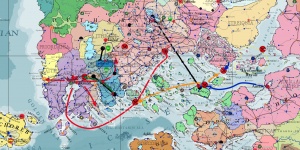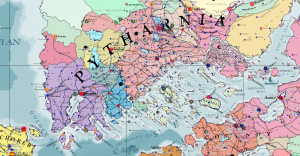Sewdhaine War
A struggle of some eighteen years in which the Archduchy of Asbardy sought to conquer Dúrandwor due to the Thrainish Controversy. The Sewdhaine War lasted from 2653 to 2671, concluding with the Peace of Amyrn (2671). The war is named after a district of central Trevirs called Sewdhainia where representatives of the King of Thrain and some of princes of Magdalan Empire gathered to protest the actions of the Emperor of Magdala. The Kingdom of Thrain which had joined the Union of Pytharnia in 2599, contested its relationship to the Empire of Magdala through the influence of the Archduchy of Asbardy. The belligerents comprised the Archduchy of Asbardy against the Empire of Magdala and her ally, the Empire of Medibgö. The Commonwealth of Thrace, the Republic of Ithatia, and the Noble Republic of Aurice were integral players. The war did not achieve the conquest of Dúrandwor (Kingdom of Thrain) for Asbardy. The equal relationship of the Kingdom of Thrain to the Magdalan Emperor was re-established[1]. The Emperor of Medibgö was maintained as first among equals. However, Asbardy made considerable gains.
The war began in earnest when Magdalan forces occupied the capital city of the Kingdom of Thrain, Verdida. Asbardy declared war on the Empire of Magdala. The King of Thrain never declared war on Magdala and never threatened to secede from the Union of Pytharnia, continually applying to the suzerain, the Emperor of Medibgö, for a resolution.
The Republic of Ithatia used the war as a pretext to attempt to win back the Shadevan Provinces. The Ithatians believed that their ally, the Empire of Magdala and the Empire of Medibgö would invade Jagohr, a puppet state of Aurice. They also did not expect the Republic of Gliri to remain neutral against Asbardy. Ithatian loyalists in the Thykomian Provinces revolted from Aurice. Unfortunately, Medibgö refused to wage war outside of Magdala or its own skynesses and Magdala in turn decided it was not powerful enough to fight Aurice and Asbardy by itself. In the Peace of Amyrn, Ithatia lost its Corundian satellites which were made independent under the influence of Republic of Johaulia, probably acting in behalf of Aurice which sought to absorb and weaken the crumbling dominion of the Republic of Ithatia. These Ithatian-speaking city-states of Corundy (Desthor, Tlathassa, Strubia, Xaphica) considered themselves colonies of Ithatian civilization, but owed cultural allegiance to Johaulia. Their liberation from the Geddamin Empire was fading into the past and they yielded to secession for political expedience.
The Empire of Magdala gained control of the Amosgire Hills, the fealty of the Duchy of Ogentir, and other neighboring principalities. Both Gonfaloys regained independence at the end of the war, but witnessed several battles. Ambrasia remained independent protected by treaty with the Commonwealth of the Ithrads. The threat of dwarven heavy infantry wielding titan-arms and borgissas was sound enough to prevent Magdala or Asbardy from nourishing any territorial expansions at her expense.
The primary battles of the Sewdhaine War were fought in the sea and in the air. The main aerial belligerents were the Archducal Knights-Draconic of Asbardy and the Asbard Skyforce against the Skyforces of Medibgö, the Republic of Ithatia, and minor principalities.
The Knights-Draconic were effective in defeating land infantry and spear-heading land-based attacks, but ineffective against titancraft sky warships. Aurice, though officially neutral, helped the Empire of Magdala.
Asbardy occupied and made subject Graith, Flisbardy, and Breomarch[2].
Aurice was not a belligerent at the onset of the war, but used agents and advisors abroad to observe and influence the war. The Republic of Gliri was also neutral, but threat of invasion by Ithatia pushed it to the Asbard side of the war against Ithatia.
Medibgö was officially on the Magdalan side of the war, but due to sympathy with Thrain, refused to war against Asbard outside the boundaries of the Empire of Magdala. After the onset of the war, saturnine fever, a magic-based plague, flared up in several skynesses of Medibgö and in Trevirs.
The Duke of Ogentir sided with the King of Thrain against his liege-lord, the Ruler of Magdala. The Empire of Magdala has no port access to the sea without the cooperation of Ogentir and Thrain.
The King of Thrain, Garframasse III, died in 2668 . His successor, King Garframasse IV, sued for peace with the Ruler of Magdala.
When Aurice defeated the Ithatian navy in the Battle of Agapsion Reef, Magdala, Medibgö, and Asbardy decide to bring the war to a close to avoid a pretext for Aurician expansion[3].
The Kingdom of Priordania was neutral until the seizure of Graith and it was clear the war was coming to a close when she threw her lot in against Asbardy.
Defection of Prince Threwggercha
The Archduke of Asbardy subverted Gonfaloy and was able to influence what later became the Principality of Gonfaloy to defect to his side in the war. The defection was accepted by treaty in 2671.
Role of Pamnests in the Sewdhaine War
Pamnests were widely used by rulers and military leaders during the twenty seventh century. Their subversion and less than perfect accuracy resulted in the limitation of their use in the present century.
Struggle of Phlogistics
Developments in the technology of antiphlogistics and symphlogistics accelerated due to the conflicts of the Sewdhaine War.
Magical Illness
A break-out of Saturnine Fever had a serious effect on Medibgö.
Treaty of Amyrn, 2671, concludes main hostilities
Partition of Gonfaloy, 2671
Chronology of the Sewdhaine War
- 2653 to 2671
- Course of War. Events dated outside of this period given to help provide a broader context.
- 2576 to 2586, Skaligdæse War
- 2587
- Treaty of Yophénthë (2587) resolves Skaligdæse War.
- 2614 to 2632, Trooskan War
- 2632
- 2648
- Aurice develops and begins use of the Baskubin in its Grand Army
- 2650
- Humans with dwarven assistance develop surface Dragonrail in Magdala and elsewhere
- 2651
- Aurice wages First Streionian War (2651 to 2657) in Streionia.
- 2652
- The Asholeki invented in Magdala and employed by the imperial troops
- Asbardy develops the Dragon Cannon, a titancraft siege weapon
- 2653
- Thrainish Controversy
- Invention of Argikeraunic Ziffler Foil
- Battle of Flisbardy (Asbard Victory)
- 2654
- Battle of Verdida (Asbard Victory)
- 2655
- 2653, Battle of Glirt Strait (Asbard Victory)
- 2656
- Aurice completes first Imperator Class Titanship
- 2657
- 2658
- Aurice invents and builds the Onogaster
- 2659
- 2660
- 2661
- mass production of hearthfast dwarvenfire weapons in southern Pytharnia
- Magdala completes first Bellatrix Class Titanship
- 2662
- Asbardy completes first Fecharunha Class Titanship
- Dagdoria completes first Mugient Class Titanship
- 2663
- 2664
- Invention of the Sparkless in southern Pythanria. Sparkless is used to cancel mage-shielding
- 2665
- 2666
- 2667
- Battle of Scarga Woods (Magdalan Victory)
- 2668
- Death of King Garframasse III, succeeded by Garframasse IV
- Joint enterprise between Aurice and Sardeichs completes the Coelodermic Volitundum
- Thykomian Revolt in Aurician Empire
- Aurice wages Second Streionian War (2668 to 2671) on its frontier
- 2669
- Magdala completes the first Wrathbringer Class Titanship
- Battle of Kumeikenot Channel (Ithatian Victory)
- 2670
- invention and use of the Tinderquench in Asbardy, used to penetrate titancraft mage-shielding
- Battle of Tisponios Reef (2670)
- Battle of Agapsion Reef (2670) (Aurician Victory)
- Desthor, Xaphica, Strubia, and Tlathassa secede from Ithatia.
- 2671
- 2671, Peace of Amyrn (2671)
- Magdala invents the Antimenion, a large titancraft artillery weapon
- 2673
- Invention of the Snuffer in Amerzcelindo, a personal titancraft device that neutralizes ignitive property of dwarvenfire
- Asbardy completes first Tempest Class Titanship.
- Magdala completes first Tarrafas Class Titanship
- 2678
- Aurice completes first Diablo Class Titanship.
- 2683
- Magdala completes first Vexillator Class Titanship.
- 2690's
- Aurice specializes the Onogaster titanship into the Wyvernian Onogaster and the Draconian Onogaster.
- 2691
- 2691 to 2694: Bijälenlander Uprising
Technology
Dragonrail played a significant function as a means of transportation of war materiel. The dragonrail system of Pytharnia was still at its beginning stages of development. Titan-arms were also important for elite troops.
Notes
Sources
- Aurician Military Engagements of the Sewdhaine War, Jamunyat ennekhá Tmaru, 2693
- Constitutions of the Empire [of Magdala]
- Early Air Battles of the Titancraft Age, 2658
- The Golden Age of Dragonmount Warfare in Pytharnia and Barathorn
- Saturnine Fever: Symptoms and Treatments
- The Story of the Sewdhaine War
See Also
- Accession of Thrain, 2599
- Annexation of Priordania (2683)
- Battle of Agapsion Reef (2670)
- Dragonrail
- Expansion of Inland Aurician Empire in Late 2600's
- Kéwb the Benighted
- Partition of Gonfaloy, 2671
- Peace of Amyrn (2671)
- Saturnine Fever
- Thracian Revolution (2574)
- Thrainish Controversy
- Thykomian Revolt
| This article is a stub. It requires further development by the creator. |

